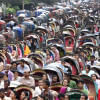From streets to heritage: UNESCO recognises rickshaws and rickshaw art as intangible cultural heritage

In a ground-breaking move, on 6 December 2023, UNESCO announced the inclusion of Bangladesh's iconic rickshaws and the vibrant rickshaw art on the Representative List of the Intangible Cultural Heritage of Humanity. The decision marks a significant recognition of the cultural richness embedded in the daily life of our country, where these three-wheeled wonders serve as both a mode of transportation and a moving art exhibition.
This momentous acknowledgement comes at a time when we are celebrating the nation's triumph in the Liberation War as it is the month of victory. Our country's rickshaws are not merely a means of getting from point A to point B – they are living canvases that traverse the bustling streets of Bangladesh – showcasing a kaleidoscope of colours and artistic expressions.
Rickshaw art tells stories of the city's history, folklore, contemporary life, and even features the faces of our celebrated movie stars! Essentially, the paintings are mobile galleries, making them an integral part of our cultural identity.

The UNESCO listing solidifies the importance of Bangladeshi rickshaw art as an intangible heritage, acknowledging its role in preserving and promoting cultural diversity. The decision highlights the art form's contribution to fostering community identity and cohesion.
Bangladesh joins the global stage alongside other traditions recognised by UNESCO, reinforcing the idea that cultural heritage extends beyond tangible monuments to include living expressions of creativity.
This is not the first time Bangladesh has made its mark on the UNESCO Intangible Cultural Heritage List. Previously, in 2017, the traditional art of Shital Pati weaving from Sylhet earned a spot on the prestigious list. In 2016, the vibrant Mangal Shobhajatra on Pahela Baishakh was recognised, and in 2013, the traditional art of Jamdani weaving received the esteemed inscription.
The announcement came as a culmination of efforts to showcase Bangladesh's rich cultural heritage. The decision to list the rickshaw art was made during the UNESCO conference held in Kasane, Botswana – adding a new chapter to the country's cultural narrative.

 For all latest news, follow The Daily Star's Google News channel.
For all latest news, follow The Daily Star's Google News channel. 





Comments